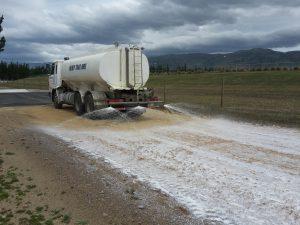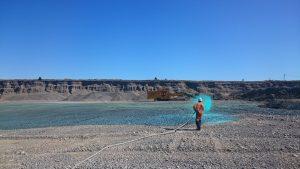Specific Tasks
Quarrying
What, and issues to look out for
What
This toolbox covers open cast pit gravel quarrying – especially common around Christchurch – and hard rock quarrying and mining. Quarries are often long-term operations and can be a major source of sediment.
Issues to look out for
Open cast pit gravel quarrying
The main issue is dust discharge from open surfaces. You should:
- Use copolymers to stabilise open areas and stockpiles
- Confine traffic to haul roads and carefully manage vehicle speed in all areas of the site
- Use dust suppressing products on roads and tracks
- Sweep sealed roads frequently so that dust isn’t tracked onto local roads.
It’s also important to minimise any open areas of water, to discourage birds from making quarries their home. The presence of large numbers of birds could cause faecal contamination of groundwater.
Hard rock quarrying and mining

Minimise dust discharges by using the best tool for the site. Here a copolymer product that copes with heavy traffic is being applied to a haul road, to suppress dust (Source: Vital Pty).
Dust suppression is also important for these types of quarries and mines, especially for haul roads and stockpiles. Overburden removal and aggregate handling are higher-risk tasks in terms of erosion and sediment control (overburden is the material that lies above the targeted rock or mineral resource). Handle overburden removal and disposal activities according to standard earthworks cut and fill operations and requirements.
Design essentials
- Treat sediment-laden runoff. Because quarries usually have a point-source discharge from the site, sediment-laden discharges can affect receiving water quality if not adequately managed.
- Many quarries are serviced by all-weather metal roads. Establishing and using these roads can generate a lot of sediment. Use rock check dams in road-side drains, and divert dirty water to a sediment retention pond (SRP) or decanting earth bund (DEB). You might need truck wash bays and run-out areas to avoid tracking sediment onto public roads.
- Quarry access roads are not always within the designated quarry area, but cover their maintenance and upkeep in your Quarry Management Plan.
- Watercourse crossings need to be authorised as a permitted activity or by a resource consent.
- Keep as much water as clean as possible. Limit the exposure of erodible surfaces and divert all clean (up-slope) water away from working and bare areas, if possible, to stop it entraining sediment. Channels will usually be the best tool to divert clean water around the working site. Plan to relocate these channels as the quarry’s footprint changes over time.
- Manage, divert and treat any quarry water runoff from bare soil areas, rock processing and aggregate wash processes before discharging it to the receiving environment. Be particularly careful with sensitive areas such as permanent watercourses, watercourse crossings and steep areas.
- Because of the texture of some Canterbury soils and the fine particles that are generated from quarrying activities, SRPs with flocculant treatment are likely to be the most successful and reliable method of treating and retaining sediment, especially for sites with a water quality discharge standard. Make sure that the SRP is fully engineered, appropriately sized for the flows and scalable if the quarry footprint/sediment pond catchment changes over time.
- Quarry-product stockpiles may need careful management. Quarry product handling and stockpile areas can be a major source of sediment-laden runoff if not properly controlled. Incorporate these areas into your site’s ESC Plan.
